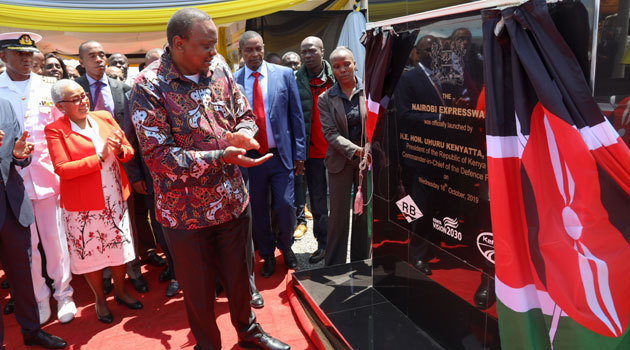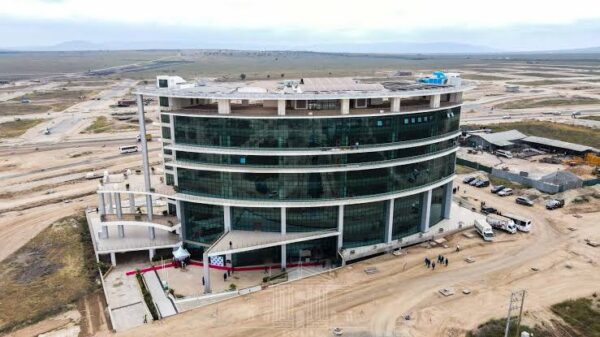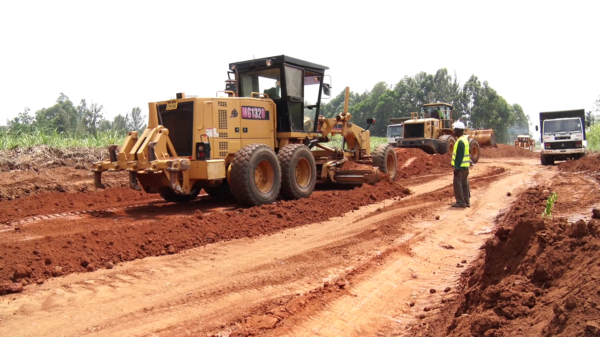
President Uhuru Kenyatta launched the construction of the double-decker road expected to reduce the heavy traffic gridlock on Mombasa Road, which usually start from Mlolongo to the city centre in October/FILE – PSCU
NAIROBI, Kenya Dec 4 – Motorists will have to fork out Sh300 to by-pass the usually gridlocked Uhuru Highway if they choose to use the Nairobi Expressway running from Mlolongo to James Gichuru Road, for their convenience.
The logic and justification behind the proposed double-decker Nairobi Expressway is not in question but it remains to be seen whether motorists will use the tolled road when they have the option to use the free highway they have been used to.
According to a study done in 2015, 61% of Kenyans said they would be willing to pay a toll to use this by-pass.
Engineer Peter Mundinia, Director General, Kenya National Highways Authority (KeNHA) said motorists were willing to pay an average of Sh6 per kilometre for personal vehicles.
“Considering that we are talking about 2015, and now we are in 2019, projected upwards the amount that we are considering to charge translates to Sh11.25,” explained Eng. Mundinia during a recent end of year dinner organised by the Institute of Engineers of Kenya (IEK).
“If you are to use the entire corridor from Mlolongo through Nairobi up to James Gichuru you will pay Sh300 for a small vehicle; if you exit anywhere in between then you will pay pro-rata,” Mundinia said.
The construction of the expressway is going to cost about Sh62 billion and this amount as a long term debt is expected to attract interest of Sh30 billion.
“The kind of money we are talking about taking into consideration operations and maintenance for the 30-year period is approximately Sh40 billion,” said Mundinia.
Support from the government is only supposed to provide the right of way … in the form of adequate land, he said.
“Along the corridor, we have services that are running on it; one of them is water … water is actually running as the median, then there’s power, there are almost 15 or more ICT service providers and all of these have to be moved at a cost of about Sh8 billion; Sh4.2 billion for land and Sh3.8 for the other services.
“The proposed Nairobi Expressway is underpinned by a concessionaire of the China Roads and Bridge Co-operation (CRBC) in a Public, Private Partnership (PPP) – they will build, design, finance, maintain and thereafter transfer to government at the end of 30 years,” explained Engineer Wangai Ndirangu, KeNHA Chairman.
After 30 years, the infrastructure will revert from the private investor to the government, said Eng. Ndirangu.
By opting for the PPP funding model, the government essentially transfers the project funding burden and responsibility to the motorists who will pay indirect road taxes in the form of a toll for its use.
The design comprises of a total of 4 lanes, two-lanes on either side with a speed limit of 80km per hour. Out of the 27 kilometre are going to be raised and 15.7 will be at the base.
The taxpayers will also foot an Sh8 billion bill to move water and sewerage lines from the path of Kenya’s first double-decker expressway in a model that is yet to be explained.
Eng. Ndirangu challenged engineers to think of new ways in which they can increase and improve the level of the country’s infrastructure.
“We know the urgent need under Nairobi Metropolitan Area Transport Authority (NaMATA) to build and operate the Bus Rapid Transit (BRT) system on all the major roads – Mombasa Road, Thika Road, the road going towards Rironi,” he said, “We also need to relocate and remove public transport vehicles from the city centre by having bus-holding termini outside town, there is need for holding stations for tracks outside town and all this will require more resources than we have now.”
President Uhuru Kenyatta launched the construction of the double-decker road expected to reduce the heavy traffic gridlock on Mombasa Road, which usually start from Mlolongo to the city centre in October.


































